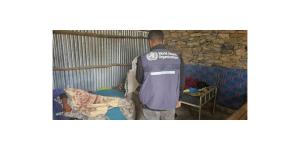Swift and effective response to acute diarrhoea disease in Adigrat, Ethiopia
In the face of health crises, timely and coordinated responses are imperative to safeguard communities from the devastating effects of outbreaks. The recent Acute Diarrhoea Disease in Adigrat, Ethiopia, underscored the critical role of proactive measures and collaborative efforts in containing infectious diseases.
Led by the World Health Organization (WHO) Adigrat sub-office and Zonal Task Force, the response to the acute diarrhoea disease exemplified a model of effective coordination and swift action. With over 110 technical officers deployed across Tigray, Afar, and Amhara regions, supported by funding from various international entities including the United States Agency for International Development (USAID), Foreign, Commonwealth & Development Office (FCDO), Humanitarian Aid Department of the European Commission (ECHO), the Central Emergency Response Fund (CERF), the German and Japanese governments. WHO swiftly mobilized resources to support the local government's response efforts.
Upon receiving a request for assistance from the Ganta-Afeshum Woreda health office, the WHO, in collaboration with local authorities, activated a Rapid Response Team (RRT) comprising public health leaders, disease surveillance officers, and medical experts. This multidisciplinary team played a crucial role in investigating and managing the cluster of acute diarrhoea disease cases.
One of the key strengths of the response was the seamless coordination between various stakeholders, including local government authorities, humanitarian organizations, and academic institutions such as Adigrat University. This collaborative approach facilitated the accurate identification and characterization of the disease, leading to swift case reporting and differentiated care for affected individuals.
The utilization of evidence-based interventions, including cholera Rapid Diagnostic Kits (RDTs) and microscopic analysis, enabled precise diagnoses of the underlying causes of Acute Diarrhoea Disease, allowing for targeted treatment and care. Moreover, the RRT's rigorous house-to-house investigations led to the identification of new cases and the specific point source of the outbreak, which was associated with a church event during the religious holiday "Debrezeyt."
In addition to containment efforts, the response strategy also prioritized community engagement and health education. The distribution of Oral Rehydration Solution (ORS) and water purification tablets, coupled with hygiene promotion activities, played a crucial role in curbing the spread of the disease and mitigating long-term risks.
Furthermore, the establishment of an isolation center and a separate trench latrine, along with the referral of severe cases to Adigrat General Hospital for specialized care, demonstrated the comprehensive nature of the response efforts.
In retrospect, the successful containment of the acute diarrhoea disease in Adigrat serves as a testament to the effectiveness of collaborative action and proactive measures in public health emergencies. By leveraging expertise from various sectors and adopting a holistic approach, WHO Adigrat sub-office and Zonal Task Force set a commendable example for future outbreak response efforts worldwide.
